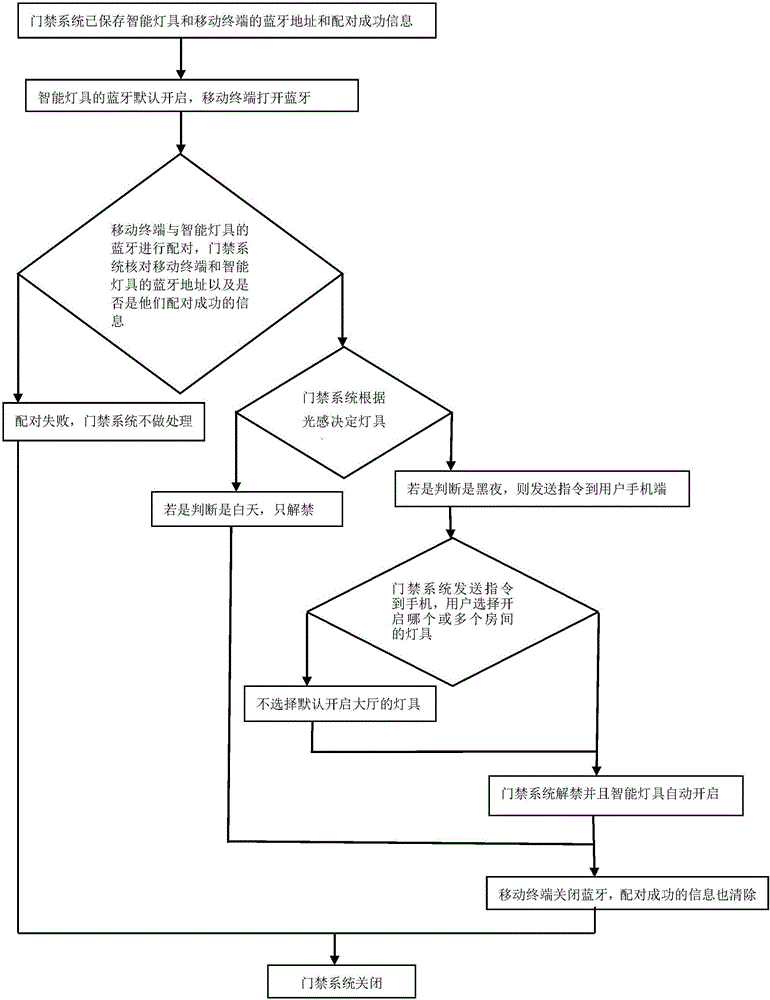Intelligent house system based on mobile terminal
A smart home system and mobile terminal technology, applied in general control systems, control/regulation systems, instruments, etc., can solve the problem of no access control system and smart home integration, and achieve the effect of adding individual choices and avoiding energy waste.
- Summary
- Abstract
- Description
- Claims
- Application Information
AI Technical Summary
Problems solved by technology
Method used
Image
Examples
Embodiment 1
[0031] The access control system of the prior art still uses passwords or fingerprint identification, which brings inconvenience to users. The technical solution of the present invention is to unlock the access control according to whether the bluetooth of the mobile terminal and the smart lamp is successfully matched, and after the successful unlocking, the smart lamp will automatically turn on the light without manually turning it on, which brings great convenience to the user. After the user enters the residence, turn off the Bluetooth of the mobile terminal, and the access control system will be automatically closed without manual closing, realizing intelligence. Since the bluetooth address of each mobile terminal is unique, the access control has high privacy.
[0032] In order to solve the above-mentioned technical problems, this embodiment is based on a mobile terminal smart home system. The mobile terminal is a Bluetooth mobile phone. The smart home system includes a B...
Embodiment 2
[0040] The difference from Embodiment 1 is that after the activation option of the smart lamp is activated, the Bluetooth access control judges whether to turn on the lamp according to the light sensing information fed back by the light sensing probe set in the user’s home. If the judgment result is that the light sensing information When the value is greater than a preset light sensitivity value, the smart lamp will not be turned on. If the judgment result is that the light sensitivity information value is less than or equal to the preset light sensitivity value, the Bluetooth access control will send the smart lamp activation information to the Bluetooth mobile phone for the user. choose. That is, the access control system judges whether to turn on the lamps or not according to the light perception. If the indoor light is sufficient, it does not need to be turned on. If the indoor light is not sufficient, the access control system sends an instruction to the user to let the u...
Embodiment 3
[0053] The differences between this embodiment and embodiment 2 are as follows:
[0054] The opening information sent by the Bluetooth access control to the Bluetooth mobile phone contains default terms, and if the Bluetooth access control does not receive a user instruction within an unpreset time, the default terms will be activated.
[0055] Generally, the preset time can be 1 minute, and it can be controlled and modified by using the mobile APP. The default terms are the opening rules for smart lamps. If the user does not issue a control command within 1 minute, the lamps in the hall and aisle will be turned on.
[0056] Other content of this embodiment can refer to Embodiment 2.
PUM
 Login to View More
Login to View More Abstract
Description
Claims
Application Information
 Login to View More
Login to View More - R&D
- Intellectual Property
- Life Sciences
- Materials
- Tech Scout
- Unparalleled Data Quality
- Higher Quality Content
- 60% Fewer Hallucinations
Browse by: Latest US Patents, China's latest patents, Technical Efficacy Thesaurus, Application Domain, Technology Topic, Popular Technical Reports.
© 2025 PatSnap. All rights reserved.Legal|Privacy policy|Modern Slavery Act Transparency Statement|Sitemap|About US| Contact US: help@patsnap.com

